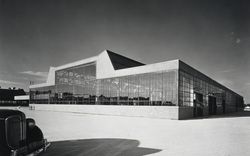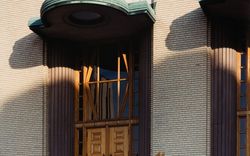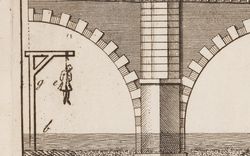The Political Life of a Building
An illustrated biography of the Panthéon
For nearly a century, the church of Sainte-Geneviève in Paris, also known as the Panthéon, was a site for attempts to impose differing ideals and to recast French history. This chronology presents some of those efforts.
Major political events are set in green.
- 1744
- At Metz, Louis XV vows to rebuild the ancient abbey church of Sainte-Geneviève in Paris
- 1748
- Treaty of Aix-La-Chapelle ends the War of the Austrian Succession
- 1755
- Jacques-Germain Soufflot takes charge of design and construction
- 1756
- Beginning of construction
Seven Years’ War begins
- 1763
- Completion of the crypt
- 1764
- Louis XV lays cornerstone of the new church in front of a full-scale canvas replica of the portico-to-be created by the painter De Machy
- 1770
- Pierre Patte launches his polemic against the stability of the building’s dome and its daringly light design
- 1774
- Accession of Louis XVI
- 1775
- Completion of portico
- 1780
- Death of Soufflot; Brébion, Rondelet, and Soufflot le Romain continue the work
- 1789
- First incidents of the Revolution
- 1790
- Rondelet completes the dome
- 1791
- Death of Count Mirabeau, 2 April
The Constituent Assembly consecrates the new Church of Sainte-Geneviève to the remains of the Great Men of the Homeland; Panthéon as such is born, 4 April
Louis XVI arrested in flight at Varennes, 21 June
The sculptor and theorist Quatremère De Quincy appointed official architect charged with converting the building from church to temple, 19 July - 1792
- Mob attack on the Tuileries Palace, 10 August
Fall of Louis XVI and the monarchy, 21 September
Proclamation of First Republic - 1794
- De Quincy imprisoned in the Madelonnettes, 2 March
Fall of Robespierre, 27 July
Transfer of Marat’s remains to the Panthéon, and expulsion of Mirabeau’s, 21 September
Transfer of Rousseau’s remains to the Panthéon, 11 October - 1796
- Stability of building again called into question; creation of special committee to study the problem
- 1801
- Napoleon, First Consul, concludes Concordat with Pope Pius VII
- 1804
- Proclamation of First Empire; accession of Napoleon I
- 1806
- Imperial decree defines new status of building, with nave as church and crypt as secular pantheon for Great Men, 20 February
Competition to complete the Madeleine as a “Temple de la Gloire”
- 1814
- Abdication of Napoleon I; accession of Bourbon Louis XVIII
- 1815
- Flight of Louis XVIII
Napoleon’s Hundred Days
Abdication of Napoleon after Waterloo, 22 June
Return of Louis XVIII - 1816
- Decree of Louis XVIII ordering reconsecration of Sainte-Geneviève, 12 April
- 1821
- Quélen, archbishop of Paris, successfully demands control of the building; tombs of Voltaire and Rousseau secretly transferred to the portico
- 1822
- Formal reconsecration of Sainte-Geneviève as a church, 21 January
- 1824
- Accession of Bourbon Charles X
- 1829
- Transfer of Soufflot’s remains to the crypt, 25 February
- 1830
- July Revolution, 27–30 July
Accession of the duke of Orléans, Louis-Philippe, as king of the French - 1830
- Royal decree, 26 August: Sainte-Geneviève “shall be rededicated to its original and legitimate purpose”—that is, to the secular commemoration of Great Men, becoming the Panthéon again in the process
- 1848
- February Revolution; fall of Louis-Philippe; proclamation of Second Republic, 22–25 February
Chenavard commissioned to decorate the building with a mural cycle on the History of Humanity, April
June insurrection, and its suppression by General Cavaignac, 23–26 June
Election of Louis Napoleon to the presidency, 10 December - 1851
- Foucault’s pendulum installed under the dome, 19 February–1 December
President Prince Louis Napoleon decrees that the Panthéon is to be returned to its religious function
Coup d’état by Louis Napoleon, 2 December - 1852
- Proclamation of Second Empire, 2 December; accession of Louis Napoleon as Napoleon III
- 1853
- Ceremony inaugurating the new Sainte-Geneviève; transfer of “relics” of Paris’s patron saint to the church, 21 January
- 1870
- Franco-Prussian War begins, 19 July
Fall of Napoleon III, 4 September
Seige of Paris begins, 19 September - 1871
- Occupation of Sainte-Geneviève by forces of the Commune
Suppression of the Commune
- 1873
- Proclamation of the Third Republic; Marshal MacMahon elected to the presidency
- 1874
- Large-scale mural decorations designed and executed by leading artists through end of century
- 1875
- Paris Municipal Council demands reestablishment of Sainte-Geneviève as a secular pantheon
- 1879
- National Assembly elections: Raspail launches campaign for secularization of the church
- 1885
- Death of “national poet” Victor Hugo
For last time, Sainte-Geneviève secularized as the Panthéon and receives Hugo’s remains - 1902
- Flammarion’s recreation of Foucault’s experiment (see 1851)
- 1913
- Beginning of a new sculptural program in the choir and nave
- 1985
- Beginning of restoration work on the Panthéon under direction of Hervé Baptiste, architect-in-chief for the Monuments Historiques de France
This chronology was adapted from a guide to our exhibition Le Panthéon: Symbol of Revolution, which we co-organized with the Caisse Nationale des Monuments Historiques et des Sites de France in 1989. Many of the drawings and photographs shown here appeared in the exhibition.


































